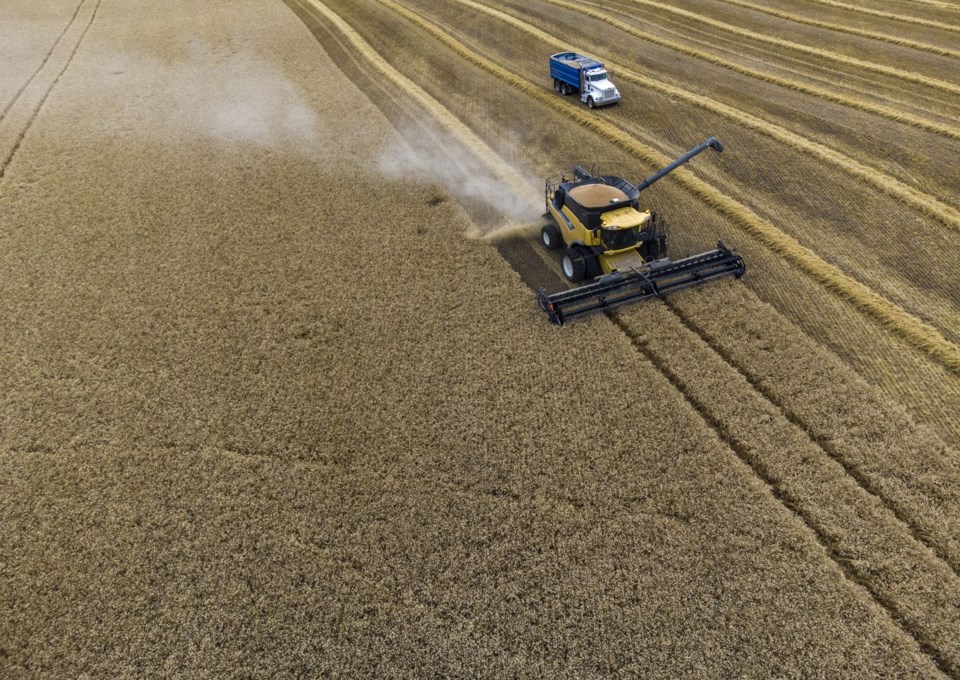CALGARY — Canada is on track to be the world's third-largest wheat exporter for the second year in a row as crop production in the prairie provinces continues to increase.
International data from the U.S. Department of Agriculture shows Canada overtaking Australia for the third-place spot in the 2023-2024 crop year, and predicts a similar ranking for 2024-25.
Canada is now behind only Russia and the European Union when it comes to volumes of wheat exports.
According to a 2024-25 outlook released last week by Agriculture and Agri-Food Canada, production of all principal field crops in the country is estimated to increase 1.8 per cent year-over-year, and 2.4 per cent above the previous five-year average.
Those figures reflect this fall's harvest, which is now largely complete, and show the impact of improved yields in Western Canada where drought conditions were not as severe as they had been the year before.
But Canada also ranked third for wheat production last year in spite of the drought, because Australian farmers suffered through their own weather-related challenges impacting crop volumes. Canada shipped close to 21.8 megatonnes of wheat to 65 countries in 2023-24, with the top five destinations being China, Indonesia, Japan, Bangladesh and the U.S., according to AAFC.
Justin Shepherd, an economist with Farm Credit Canada, said while the global rankings can fluctuate from year to year due to weather conditions in specific geographic areas, Canada as a whole has been increasing its wheat export volumes over time due to advances in agricultural research and crop genetics.
"We did see a much smaller wheat crop to export in 2021 due to a fairly significant drought on the prairies that year. But overall, as long as Canada is able to grow an average or above-average crop, we have seen exports grow over time," Shepherd said.
Global demand for wheat has also been growing. The USDA has projected global wheat consumption in 2024/25 will increase by 0.6 per cent, with increased demand from North America, the Middle East, and Southeast Asia.
Durum wheat, a variety of wheat that is used to make pasta and is grown in Canada's southern prairie provinces, is seeing strong demand from Europe and North Africa. The Canadian Grain Commission has said durum exports from Canada through the country's licensed elevator system are running approximately 25 per cent ahead of last year's figures so far this fall.
Wheat is a “thirstier” crop than other staples such as maize, rice and soy, making it more vulnerable to water shortages. The Washington-based World Resources Institute estimates that by 2040, nearly three-quarters of global wheat production will be under threat owing to drought and climate change-induced water supply stress.
But Stewart Oke, a central Alberta farmer and a director with the producer organization Alberta Grains, said Canada continues to invest in crop research and development, which has allowed the country's farmers to continue to increase their yields over time.
"In Canada we've worked really hard on our wheat genetics to withstand some of the drought stress that maybe previous varieties of wheat didn't have," Oke said.
"It does seem as if in Canada we've been able to continue to be increasing our wheat yields and production in spite of some significant weather challenges in recent years."
He added Canadian wheat exporters are also benefiting from the lower Canadian dollar, which makes the country's agricultural commodities more attractive to global customers.
"Not only are they getting the best wheat in the world, but they're able to buy it at a bit of an exchange deficit, which just makes it more affordable for those buyers," Oke said.
Farming as an industry remains governed by Mother Nature, and Oke said no amount of advancements in crop genetics or technology can save a crop if no rain comes. But he said Canadian farmers are keen to continue rising up the global rankings when it comes to wheat export volumes.
"It's certainly a feather in Canada's cap — particularly Western Canada — to move into that third spot," Oke said.
"Both from a producer level, but also as an export market, we want to hold that third position."
This report by The Canadian Press was first published Oct. 28, 2024.
Amanda Stephenson, The Canadian Press



